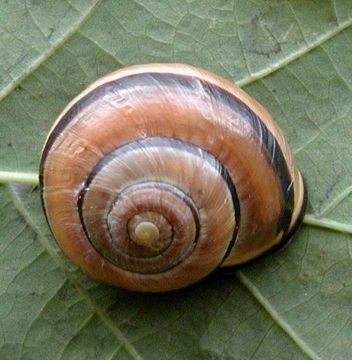Adaptation
Terrestrial gastropods have evolved a number of adaptations which have allowed them to live in more harsh environments. Some snails possess a structure that provides them with protection called an operculum (Hickman, et. al 2012). The operculum is a hard plate that is made up of proteins and covers the opening of the organism’s shell when it pulls its body back inside (Hickman, et. al 2012). This adaptation helps the snail with protection and keeps its body from drying out (Hickman, et. al 2012).
This species also has a coiled shell. By having a coiled shell, it is more compact and allows for ease in locomotion by the organism (Hickman, et. al 2012). The method of coiling occurs simultaneously as another adaptation, called torsion, during development of the gastropod (Hickman, et. al 2012). Torsion is the process that they go through during development that involves twisting (Hickman, et. al 2012). The development of torsion solves the initial problem of the mouth and anus being located in two different spots increasing the risk of predation (Hickman, et. al 2012). The anus and mouth are now both located in the same area (Hickman, et. al 2012). Mesodon sanus and other terrestrial snails developed this form to increase protection. A possible problem that can occur from torsion is fouling which is when snail’s waste is excreted over the gills (Hickman, et. al 2012). Due to the adaptation of torsion, some changes needed to be made for the decrease in size (Gastropoda, 2002). Gastropods only have a single kidney and auricle in order to take into account for this loss of space (Gastropoda, 2002). This adaptation helps to distribute the weight of the organism and create better balance (Gastropoda, 2002). Another way to adapt to the changes in balance is the shifting of the shell so that it is oriented asymmetrically (Gastropoda, 2002). The spiral portion of the shell is slanted in an upward position and somewhat backward position (Gastropoda, 2002). Having a coiled shell and having evolved torsion are just two of the adaptations of this species.
Mesodon sanus is also part of the subclass Pulmonata. They have developed specialized organs to help with respiration. This group no longer has a gill and the mantle has evolved into an operative lung (Hickman, et. al 2012). The lung, as well as the anus, open to the outside and are able to release water powerfully using air from within it (Hickman et. al, 2012). Respiration in Gastropods takes place when the mantle floor constricts and compresses (Gastropoda, 2002). Oxygen enters into the lung via the pneumostome and causing the air pressure to rise (Gastropoda, 2002). Once optimum air pressure is obtained, the pneumostome closes and the increased pressure enables oxygen uptake into the wall compartments of the vascularized mantle (Gastropoda, 2002). During this process, air is also being pushed out (Gastropoda, 2002).
To learn about the Nutrition of this species, go to the next page.

